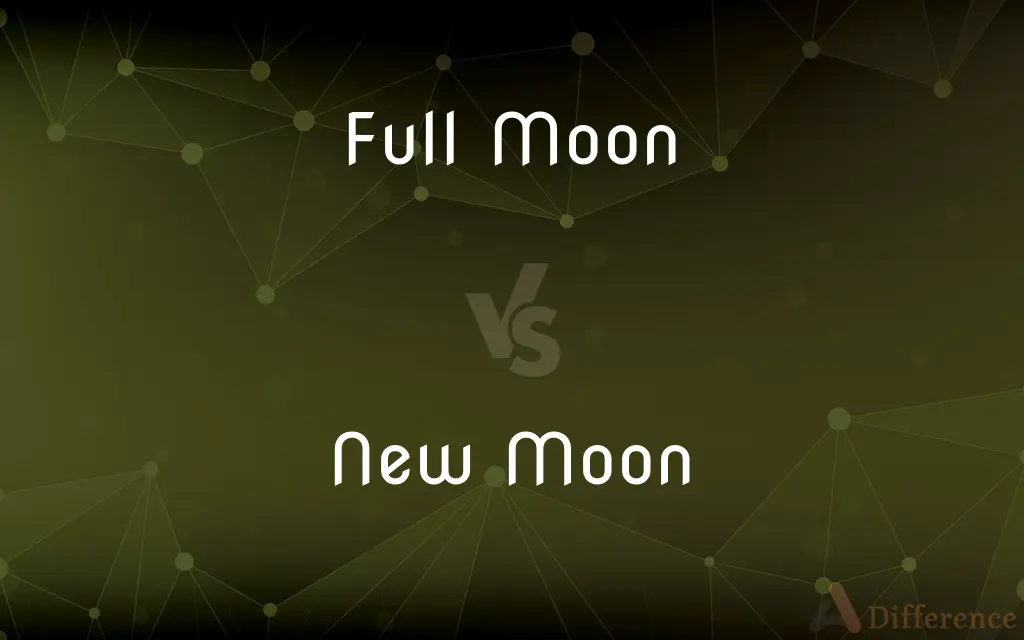Full Moon vs. New Moon — What's the Difference?
By Tayyaba Rehman — Published on November 29, 2023
A Full Moon occurs when the moon's face is fully illuminated, whereas a New Moon is when it's completely shadowed and not visible from Earth.

Difference Between Full Moon and New Moon
Table of Contents
ADVERTISEMENT
Key Differences
A Full Moon represents a phase in the lunar cycle when the Earth is positioned between the sun and the moon. At this time, the entire face of the moon that's visible from Earth is brightly lit up by the sun's rays, making it appear as a complete circular disk in the night sky.
In contrast, a New Moon denotes the phase when the moon is located between the Earth and the sun. During this phase, the side of the moon that faces the Earth is in shadow, rendering it invisible to observers. In other words, the moon's side that receives sunlight is facing away from our planet.
The phenomenon of a Full Moon is often linked to various cultural myths, legends, and even certain behavioral changes in both humans and animals. It's a time when the nighttime landscape is relatively brighter, thanks to the moon's full reflection of sunlight.
On the other hand, the period of a New Moon is characterized by the darkest nights since the moon doesn't illuminate the sky. This phase is particularly significant for astronomers and stargazers as it provides the perfect backdrop to observe stars and celestial bodies without the interference of moonlight.
In summary, while the Full Moon stands out as a radiant orb in the sky due to full illumination, the New Moon is notable for its absence, leading to darker nights and a moonless sky.
ADVERTISEMENT
Comparison Chart
Visibility
Fully illuminated and visible
Not illuminated and not visible
Position relative to Earth & Sun
Earth is between the sun and the moon
Moon is between the Earth and the sun
Impact on Night's Brightness
Brighter night due to moon's reflection
Darkest nights with no moonlight
Cultural Significance
Often linked to myths and behavioral changes
Signifies new beginnings in many cultures
Best for
Observing moon's features
Stargazing and observing other celestial bodies
Compare with Definitions
Full Moon
A lunar phase where the entire moon's face visible from Earth is illuminated.
The Full Moon lit up the entire countryside, casting long shadows.
New Moon
A lunar phase where the moon's side facing Earth receives no sunlight.
During a New Moon, the night sky is devoid of moonlight, perfect for stargazing.
Full Moon
The brightest phase of the lunar cycle.
The beach looked magical under the Full Moon's glow.
New Moon
The time when the moon lies between the Earth and the sun.
The New Moon marks the beginning of a new lunar cycle.
Full Moon
The time when the Earth lies directly between the sun and the moon.
During a Full Moon, lunar landscapes are more visible through telescopes.
New Moon
A phase characterized by the moon's invisibility from Earth.
Observers on Earth cannot see the New Moon due to its position.
Full Moon
The midpoint of the lunar cycle.
We planned our night hike to coincide with the Full Moon for better visibility.
New Moon
A symbolic phase denoting new beginnings in many cultures.
Some cultures start new ventures on the New Moon for good luck.
Full Moon
A celestial event causing the moon to appear as a complete circle in the night sky.
Legends often speak of strange events occurring during the Full Moon.
New Moon
The darkest phase in the lunar calendar.
The New Moon night was so dark that it was hard to see without artificial light.
Common Curiosities
What is a Full Moon?
A Full Moon is when the entire moon's face visible from Earth is fully illuminated.
How often does a Full Moon occur?
A Full Moon occurs roughly every 29.5 days, aligning with the lunar cycle.
What's the link between Full Moons and tides?
Full Moons (and New Moons) lead to spring tides, causing higher high tides and lower low tides due to gravitational forces.
Why does a Full Moon appear so bright?
A Full Moon is bright because it fully reflects the sun's rays onto Earth.
Does the Full Moon affect human behavior?
While many myths suggest behavioral changes during a Full Moon, scientific evidence is inconclusive.
How does a New Moon differ from a Full Moon?
A New Moon is when the moon is positioned between the Earth and sun, making it invisible, while a Full Moon is fully illuminated.
Why is a New Moon significant for stargazers?
A New Moon means darker skies, ideal for observing stars without moonlight interference.
When can we not see the moon at all?
During the New Moon phase, the moon is not visible from Earth.
Are there any special Full Moons?
Yes, terms like "Blue Moon," "Harvest Moon," and "Supermoon" denote specific Full Moon events.
What happens to the moon after a New Moon?
After a New Moon, the moon enters the waxing crescent phase, becoming more visible each night until it reaches a Full Moon.
Can you see any part of a New Moon?
Typically, no. The New Moon's illuminated side faces away from Earth, making it invisible.
Is the New Moon the same as a solar eclipse?
Not always, but a solar eclipse does occur during a New Moon when the moon aligns perfectly between the Earth and sun.
Why do Full Moons have names like "Wolf Moon" or "Strawberry Moon"?
These names, often derived from Native American cultures, relate to seasonal changes or events corresponding to each month's Full Moon.
Can Full Moon and New Moon phases affect animals?
Some studies suggest certain animals exhibit different behaviors during these phases, like coral spawning at Full Moon.
Does the New Moon hold spiritual significance?
Yes, in many cultures, a New Moon symbolizes new beginnings and is a time for setting intentions.
Share Your Discovery

Previous Comparison
Salsa vs. Picante Sauce
Next Comparison
Himalayan Rivers vs. Peninsular RiversAuthor Spotlight
Written by
Tayyaba RehmanTayyaba Rehman is a distinguished writer, currently serving as a primary contributor to askdifference.com. As a researcher in semantics and etymology, Tayyaba's passion for the complexity of languages and their distinctions has found a perfect home on the platform. Tayyaba delves into the intricacies of language, distinguishing between commonly confused words and phrases, thereby providing clarity for readers worldwide.
















































